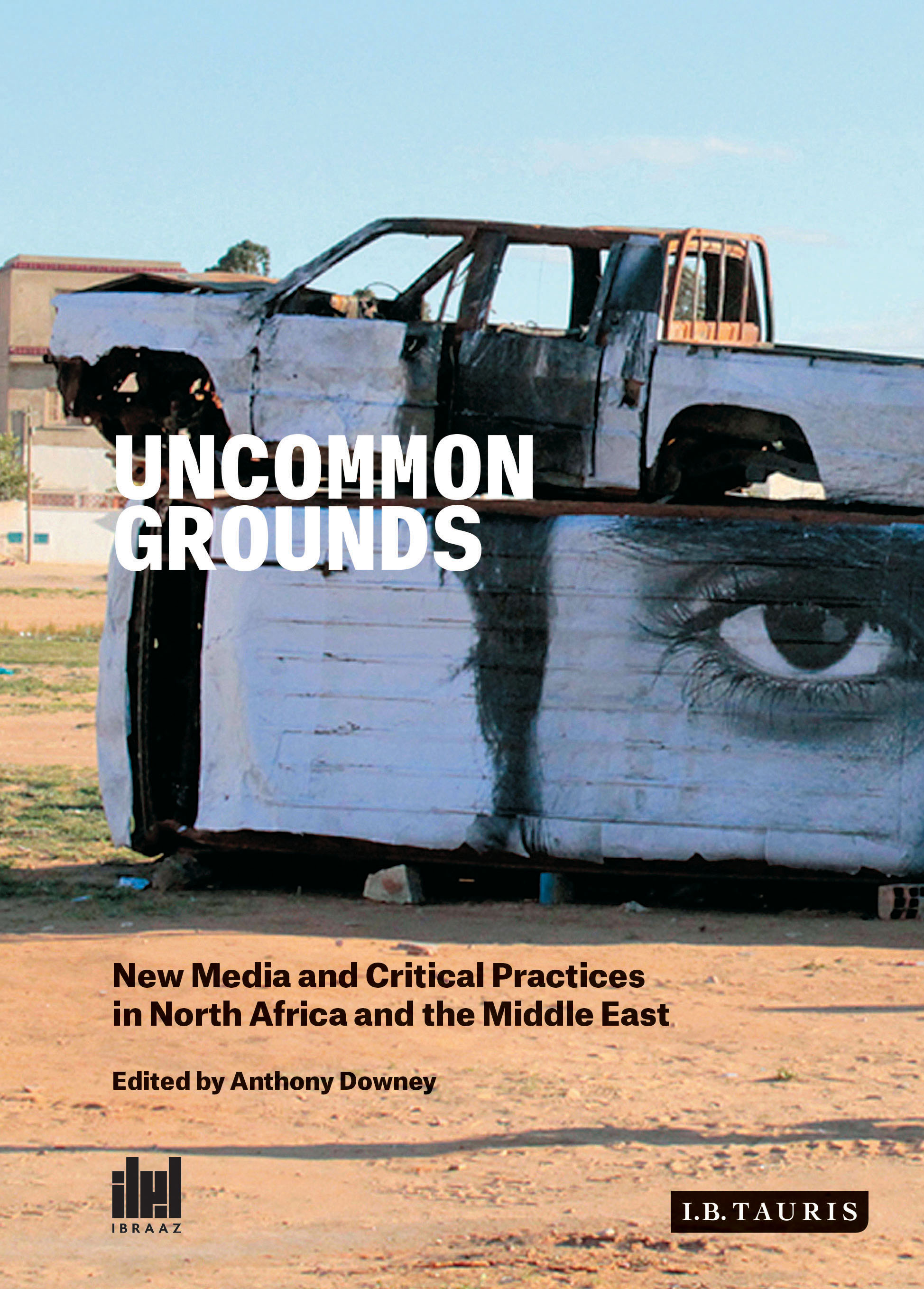Uncommon Grounds: New Media and Critical Practices in North Africa and the Middle East Review
Published ······ Online, Nov 2014
Section ······· Art & Design

Book cover, courtesy of Ibraaz
Uncommon Grounds: New Media and Critical Practices in North Africa and the Middle East's primary contribution is to frame revolutionary features in various
countries in the Middle East and North Africa by contextualising the
region and the role that enormous new media has played in dismantling
regimes and creating new social movements.
The anthology of essays
edited by Anthony Downey, Editor-in-Chief of Ibraaz, pulls together
critical essays and full-colour inserts of artwork with a
socio-political slant exploring the overlap of the role of new media and
visual culture. The book presents a new analysis paradigm that moves
beyond merely framing the elements of the social movements within their
historical backgrounds and political interpretations, and instead
engages with the specifics of the accountability of new media in the
democratic movements.
Grassroots movements once relied on
handwritten pamphlets and word of mouth, while now the resources
available to create specific change or to push for certain issues are
expansive, powerfully visible, and, critically, they are immortal. The
central role played by YouTube, Facebook, and Twitter ties the whole
collection together. “The internet helped create the aura that all this
was familiar…the Internet replaced the Kalashnikov” writes Philip Rizk,
an independent filmmaker based in Cairo, in his essay ‘2011 is not 1968’
(p. 31).
The transmission of important news events via citizen
broadcasting is actively transforming the landscape in the Middle East
and North Africa. Countries such as Syria and Egypt who once were able
to block their citizen’s access to international news channels are now
finding it almost impossible to effectively control access to such
information. It makes it increasingly difficult for those culpable to
bypass consequences or feign ignorance.
Another effect associated
with narratives provided by new media is the fabrication of collective
memory, a constant theme throughout the book. In Jens Maier-Rothe, Dina
Kafafi, and Azin Feizabadi’s essay 'Citizen Reporting and the
Fabrication of Collective Memory' the oftentimes “uncategorized and
chaotic” information sharing still proves to be effective in
disseminating information and thus radically alter society’s collective
reality. The piece later goes on to explore the concept of ‘citizen
journalism’ associated with the prevalence of new media and how “new
forms of reporting also condition new forms of spectatorship…”(p. 75).
The role of observers and their manifestation in visual culture as a
means to explore, promote, and understand events and movements is
another consistent theme in the anthology.
Other articles
establish new conceptual terrain by framing newly forming implications
for the regional art movement as a whole. The entire approach to art is
explored in Derya Yucel’s essay, 'Art’s Networks: A New Communal Model.'
Developments in technology altering language and creative expression in
Turkey is explored and fascinatingly delves in to how ‘net art’ is
further developing new positions against established art institutions in
the country’s more established art landscape.
Sheyma Buali’s
‘Digitial, Aesthetic, Ephemeral’ explores the change produced works of
art undergo throughout the different stages of revolutions, observing
the cycle of raw material being sourced, and how materialisation of
visual culture is constantly altering based on a society’s sentiments.
The
rest of the chapters unfold as a more traditional examination of
various issues related to the role of certain artistic manifestations in
the social movements. The strength of the book lies in the diversity of
the selection of art as well as the scope of area studies and
theoretical frameworks. The range of subjects and approaches provides a
wide degree of concepts developed. Some chapters include an expansive,
sophisticated theoretical framework while others are mostly explanations
of certain events. Short artistic briefs explaining their artworks are
scattered throughout the book. The variation is refreshing and allows
the anthropology to be appreciated from a multitude of angles and
perspectives, despite the subsequent unevenness in the chapters.
Tarek
Khoury argues in his essay ‘The Art of the Written Word and New Media
Dissemination: Across the Borders between Syria and Lebanon’ that
“Syrian activists are constantly doing at least one of the following:
expressing, recording and/or disseminating (p. 302).” The statement can
be applied across the board to all activists working in the Middle East
and North Africa.
While several of the chapters discuss the impact
of geopolitics, none provide a thorough examination of the crucial
importance of how the cultural scene in the Middle East and North Africa
intersects with the rest of the world, which would have provided
additional insight.
Anthony Downey writes in his article ‘For the
Common Good? Artistic Practices and Civil Society in Tunisia,’ “If art
is indeed increasingly positioned as ‘political’ by virtue of being
denied a role in the political realm, it is obvious that it is
considered capable of potentially altering opinion, not to mention
reconfiguring engagement with various communities” (p. 60).
It’s
the revolutionary potential of art, with the facility provided by new
media platforms that ensures art’s impact remains unpredictable, yet
steadfastly critical in social relations. Uncommon Grounds
provides a comprehensive narrative of the region’s current transitional
moment and the expansive role of new media, for the first time.
Uncommon Grounds: New Media and Critical Practices in North Africa and the Middle East is published by I.B.Tauris in association with Ibraaz. More information on the book via I.B. Tauris.
ibraaz.org
